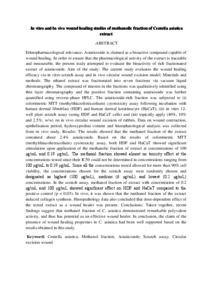Citation
Abdul Azis, Huwaida and Taher, Muhammad and Ahmed, Afnan Sh and W.an Sulaiman, Wan Mohd Azizi and Darnis, Deny Susanti and Chowdhury, Shiplu Roy and Zakaria, Zainul Amiruddin
(2017)
In vitro and In vivo wound healing studies of methanolic fraction of Centella asiatica extract.
South African Journal of Botany, 108.
pp. 163-174.
ISSN 0254-6299; ESSN: 1727-9321
Abstract
Ethnopharmacological relevance: Asiaticoside is claimed as a bioactive compound capable of wound healing. In order to ensure that the pharmacological activity of the extract is traceable and measurable, the present study attempted to evaluate the bioactivity of rich fractionated extract of asiaticoside. Aim of the study: The current study evaluates the wound healing efficacy via in vitro scratch assay and in vivo circular wound excision model. Materials and methods: The ethanol extract was fractionated into seven fractions via vacuum liquid chromatography. The compound of interest in the fractions was qualitatively identified using thin layer chromatography and the positive fraction containing asiaticoside was further quantified using reverse-phase HPLC. The asiaticoside-rich fraction was subjected to (i) colorimetric MTT (methylthiazoltetrazolium) cytotoxicity assay following incubation with human dermal fibroblast (HDF) and human dermal keratinocyte (HaCaT); (ii) in vitro 12-well plate scratch assay (using HDF and HaCaT cells) and (iii) topically apply (40%, 10% and 2.5%, w/w) on in vivo circular wound excision of rabbits. Data on wound contraction, epithelisation period, hydroxyproline content and histophatological analysis was collected from in vivo study. Results: The results showed that the methanol fraction of the extract contained about 2.4% asiaticoside. Based on the results of colorimetric MTT (methylthiazoltetrazolium) cytotoxicity assay, both HDF and HaCaT showed significant stimulation upon application of the methanolic fraction of extract at concentrations of 100 μg/mL and 0.19 μg/mL. The methanol fraction showed almost no toxicity effect at the concentrations tested since their IC50 could not be determined in concentrations ranging from 100 μg/mL to 0.19 μg/mL. Since all the concentrations tested allowed for more than 90% cell viability, the concentrations chosen for the scratch assay were randomly chosen and designated as highest (100 μg/mL), medium (6 μg/mL) and lowest (0.2 μg/mL) concentrations. In the scratch assay, methanol fraction of extract with concentration of 0.2 μg/mL and 100 μg/mL showed significant effect on HDF and HaCaT compared to the positive control (p < 0.05). In vivo, it was shown that the methanol fraction of the extract induced collagen synthesis. Histopathology data also concluded that dose-dependent effect of the tested extract as a wound healer was present. Conclusions: Taken together, recent findings suggest that methanol fraction of C. asiatica demonstrated remarkable polyvalent activity, and thus has potential as an effective wound healer. In conclusion, the claim of the presence of wound healing properties in C. asiatica had been well supported based on the results obtained in this study.
Download File
![[img]](http://psasir.upm.edu.my/62134/1.hassmallThumbnailVersion/In%20vitro%20and%20In%20vivo%20wound%20healing%20studies%20of%20methanolic%20fraction%20of%20Centella%20asiatica%20extract.pdf)  Preview |
|
Text
In vitro and In vivo wound healing studies of methanolic fraction of Centella asiatica extract.pdf
Download (154kB)
| Preview
|
|
Additional Metadata
Actions (login required)
 |
View Item |

